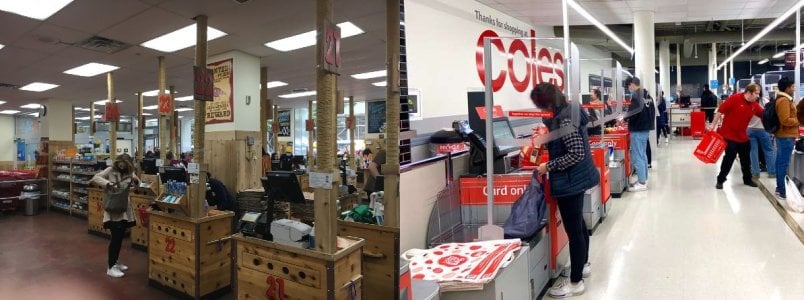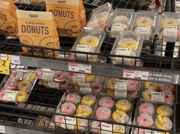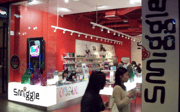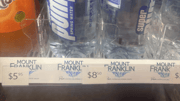Aussies will be shocked by what US supermarkets offer compared to Coles & Woolworths!
- Replies 11
When it comes to grocery shopping, Australians are well-acquainted with the self-serve checkout lines at Coles and Woolworths.
However, a glimpse into the bustling aisles of a US supermarket in the heart of New York City reveals a very different scene that might just leave Aussie shoppers stunned.
Imagine this: It's 6:00 PM, and the supermarket is teeming with customers. A line winds around the store all the way to the escalator entrance.
Twenty cash registers are manned by eager cashiers, each holding up a paddle to signal they're ready for the next customer.
Employees are strategically placed throughout the store, one holding a sign indicating the end of the queue, another directing traffic across busy aisles, and yet another at the front of the line managing the flow to the free registers.

There's a welcoming presence at the door, a team organising trolleys, and over twenty staff members bustling about, restocking shelves in the crowded underground store.
However, there's something conspicuously absent from this picture: self-serve checkouts.
Trader Joe's, an upscale grocery chain with a significant presence of 571 branches across the US, has made a deliberate choice to eschew this technology in favour of a focus on customer service.
This is a stark contrast to the Australian supermarket giants Coles and Woolworths, which are increasingly embracing technology and reducing customer-facing roles.
Even budget retailer ALDI has been forced to adapt as Australia increases its use of surveillance with rooftop sensors, self-service cameras, and automatic gates at some checkout areas.
It raises the question: Is America trailing just behind Australia, or are they onto something?
Trader Joe’s isn’t alone in moving away from self-service in the US. Despite spending hundreds of millions on the technology, many major US retailers have scaled back on self-serve options in recent years.
Discount store Target has limited self-checkout purchases to 10 items, while Walmart has either removed self-checkout kiosks from some locations or is offering them as a membership benefit for faster checkout in others.
Dollar General, which fully embraced self-checkout technology in 2022 and operates a massive 20,000 stores nationwide, has recently reversed course.
The retail giant has already removed self-checkout from 9,000 stores, with another 3,000 losing their self-checkout lanes in May.
Experts attribute this shift primarily to theft. Leading grocery analyst Phil Lempert noted that the impact of ‘shrink’—industry jargon for shoplifting—has been ‘huge’.
‘Grocers that I talk to tell me off the record that shrink is three to four times higher since the pandemic on self-checkout,’ he reported.
‘Lots of people are tricking the machine and scanning cheaper items that have similar weight to the actual item they are purchasing.’
While Australia is increasing its investment in surveillance to reduce theft, America appears to be moving in the opposite direction.
Santiago Gallino, an associate professor of operations, information, and decisions at Wharton School, stated that America’s low wages make it ‘less urgent for businesses to adopt costly self-checkout systems’.
‘The return on investment for these machines might not be as attractive when labour costs are comparatively low,’ he speculated.
‘Self-checkout machines require ongoing maintenance, updates, and supervision, which adds to the cost.’
The federal minimum wage in the United States is US$7.25 (AU$10.70) per hour, while in Australia, it is AU$24.10 per hour, though several states in the US have higher wage standards.
In a company podcast last year, Trader Joe’s President and Vice CEO stated that the chain had no intentions of introducing self-checkout kiosks in its stores.
‘We believe in people. We’re not trying to get rid of our crew members for efficiency’s sake,’ Jon Basalone said.
He mentioned finding the technology confusing, citing a recent experience he had at a different store.
‘I was in a store, and I couldn’t get the thing to scan…and then the person came over and was trying to explain to me,’ he recalled.
‘I’m like, I do this for a living, and I can’t get this thing to work.’
Trader Joe’s CEO Bryan Palbaum concurred, saying, ‘It’s (self-serve) not fun.’
‘I have fun bagging groceries and working at the register. Self-checkout is work. I don’t want that.’

Recent polling by Newsweek revealed that 43 per cent of Americans supported eliminating self-checkouts from retail stores.
Professor Santiago noted that Americans had ‘mixed feelings’ about self-checkout.
‘While some appreciate the speed and convenience, others find the technology frustrating, especially when there are issues like item scanning errors or needing assistance with age-restricted items,’ he pointed out.
He explained that retailers like Trader Joe’s were intentionally choosing to focus on providing a ‘customer-centric shopping experience’.
‘For these companies, the personal interaction between staff and customers is a key part of their brand identity, which they believe could be diminished with self-checkouts,’ Professor Santiago explained.
Mr Lempert concurred, highlighting the significance of customer experience in America.
‘The checkout is the last touch point for the store—and especially with grocery prices as high as they are—having someone verbally thank you is a plus,’ he said.
The system in Australia is far from flawless. To combat rising theft, major supermarkets have been criticised for treating customers like criminals by increasing high-tech surveillance in stores.
Coles and Woolworths have introduced ceiling cameras that give each shopper a digital ID and monitor their movements in the self-checkout area.
They have also started installing ‘smart’ exit gates that block customers from leaving the self-serve area until their purchases are verified.
They’ve also partnered with a New Zealand start-up called Auror, a retail crime intelligence platform named after the magical police from the Harry Potter series.
The software uses CCTV data—such as gender, distinctive features, age, and build—to alert stores when known shoplifting suspects return, aiming to prevent theft.
Lauren Kelly, a PhD candidate at the Australian Research Council’s Centre of Excellence for Automated Decision-Making and Society at RMIT University, cautioned against the dangers of excessive surveillance.
‘These heavy-handed measures seek to make self-service checkouts more secure without increasing staff numbers,’ she stated.
‘This leads to something of a vicious cycle, as under-staffing, self-checkouts, and high prices are often causes of customer aggression to begin with.’
‘Many staff are similarly frustrated by historical wage theft by the supermarkets that totals hundreds of millions of dollars,’ Ms Kelly added.
According to her, the surveillance measures ‘treat every customer as a potential thief’.
Earlier this year, Coles justified its security measures in a statement.
‘The safety of our team members and customers is our top priority, and we have a range of security measures in place to reduce theft from our stores, including security personnel and surveillance technologies such as CCTV,’ Coles said.
‘Some of our cameras, such as the ones that display a live feed of the customer on their self-service screen as they complete their shop, do not record or collect personal information. Any CCTV footage that is recorded is done so in line with all relevant laws and Coles’ Privacy Policy.’
‘Like most businesses and public spaces, we use surveillance technologies in accordance with stringent privacy laws, and we have strict protocols in place around access to the footage,’ they continued.
Woolworths also supported its surveillance practices.
‘We have a number of initiatives that we use, both covert and overt, to help reduce retail crime, which currently mirrors a level that we experienced prior to the COVID-19 pandemic,’ a spokesperson stated.
‘These initiatives include the use of camera technology at the check-outs, double welcome gates, CCTV and a trial of gates at the exit to our self-serve checkout area.’
‘We also continue reviewing our health and safety controls to ensure we’re doing everything we can to keep our team and customers safe in our stores, and this remains our absolute priority.’
‘We use technology such as team safety cameras and VR Training modules to both support and prepare our team members for instances where they may feel unsafe,’ they added.
Experts are split on the future of grocery shopping in America and Australia.
Professor Gary Mortimer, a retail expert from Queensland University of Technology Business School, predicted that delivery services would become a major focus.
‘As online grocery shopping continues to increase, US retailers may “shift” or “re-allocate” roles from the front of the store to online picking and packing,’ he explained.
‘This would mean the introduction of self-serve technologies.’
He noted that Coles and Woolworths’ annual reports, released this week, showed online shopping services had increased by over 20 per cent.
Professor Mortimer suggested that Australian supermarkets would likely continue using self-serve checkouts and eventually adopt new technologies such as ‘smart carts’ and ‘just walk-out tech’.
Meanwhile, grocery expert Phil Lempert anticipated that these technologies would ‘replace’ self-checkout in America.
Associate Professor Gallino predicted that American retail chains would likely adopt a more ‘balanced approach’ to self-service in the future, rather than making a ‘wholesale shift’.
‘Retailers are likely to continue experimenting with self-checkout, particularly in areas where labour costs are higher or where consumer demand for quick transactions is stronger,’ he said.
‘Some stores may adopt hybrid models, offering both self-service and staffed checkout lanes to cater to different customer preferences.’
As the American retail scene evolves, with a growing emphasis on new technologies and delivery services, Australian supermarkets are also facing their own challenges.
Recent trends in grocery shopping reveal a stark contrast between the advanced tech solutions being explored overseas and the issues encountered closer to home.
For instance, a recent incident at a Coles self-serve checkout highlights the growing scrutiny on self-checkout systems and their impact on the customer experience.
As Australia navigates its approach to self-service and surveillance, these developments underscore the ongoing debate about balancing efficiency with customer satisfaction.

How do you feel about the increasing reliance on self-serve checkouts and surveillance in Australian supermarkets? Do you miss the personal touch of a staffed checkout, or do you prefer the speed and autonomy of doing it yourself? Share your thoughts and experiences with us in the comments below!
However, a glimpse into the bustling aisles of a US supermarket in the heart of New York City reveals a very different scene that might just leave Aussie shoppers stunned.
Imagine this: It's 6:00 PM, and the supermarket is teeming with customers. A line winds around the store all the way to the escalator entrance.
Twenty cash registers are manned by eager cashiers, each holding up a paddle to signal they're ready for the next customer.
Employees are strategically placed throughout the store, one holding a sign indicating the end of the queue, another directing traffic across busy aisles, and yet another at the front of the line managing the flow to the free registers.

Unlike Coles and Woolworths in Australia, Trader Joe's in the US opts for staffed checkouts and prioritises customer service over self-serve options. Credit: Happy Cow & Shutterstock
There's a welcoming presence at the door, a team organising trolleys, and over twenty staff members bustling about, restocking shelves in the crowded underground store.
However, there's something conspicuously absent from this picture: self-serve checkouts.
Trader Joe's, an upscale grocery chain with a significant presence of 571 branches across the US, has made a deliberate choice to eschew this technology in favour of a focus on customer service.
This is a stark contrast to the Australian supermarket giants Coles and Woolworths, which are increasingly embracing technology and reducing customer-facing roles.
Even budget retailer ALDI has been forced to adapt as Australia increases its use of surveillance with rooftop sensors, self-service cameras, and automatic gates at some checkout areas.
It raises the question: Is America trailing just behind Australia, or are they onto something?
Trader Joe’s isn’t alone in moving away from self-service in the US. Despite spending hundreds of millions on the technology, many major US retailers have scaled back on self-serve options in recent years.
Discount store Target has limited self-checkout purchases to 10 items, while Walmart has either removed self-checkout kiosks from some locations or is offering them as a membership benefit for faster checkout in others.
Dollar General, which fully embraced self-checkout technology in 2022 and operates a massive 20,000 stores nationwide, has recently reversed course.
The retail giant has already removed self-checkout from 9,000 stores, with another 3,000 losing their self-checkout lanes in May.
Experts attribute this shift primarily to theft. Leading grocery analyst Phil Lempert noted that the impact of ‘shrink’—industry jargon for shoplifting—has been ‘huge’.
‘Grocers that I talk to tell me off the record that shrink is three to four times higher since the pandemic on self-checkout,’ he reported.
‘Lots of people are tricking the machine and scanning cheaper items that have similar weight to the actual item they are purchasing.’
While Australia is increasing its investment in surveillance to reduce theft, America appears to be moving in the opposite direction.
Santiago Gallino, an associate professor of operations, information, and decisions at Wharton School, stated that America’s low wages make it ‘less urgent for businesses to adopt costly self-checkout systems’.
‘The return on investment for these machines might not be as attractive when labour costs are comparatively low,’ he speculated.
‘Self-checkout machines require ongoing maintenance, updates, and supervision, which adds to the cost.’
The federal minimum wage in the United States is US$7.25 (AU$10.70) per hour, while in Australia, it is AU$24.10 per hour, though several states in the US have higher wage standards.
In a company podcast last year, Trader Joe’s President and Vice CEO stated that the chain had no intentions of introducing self-checkout kiosks in its stores.
‘We believe in people. We’re not trying to get rid of our crew members for efficiency’s sake,’ Jon Basalone said.
He mentioned finding the technology confusing, citing a recent experience he had at a different store.
‘I was in a store, and I couldn’t get the thing to scan…and then the person came over and was trying to explain to me,’ he recalled.
‘I’m like, I do this for a living, and I can’t get this thing to work.’
Trader Joe’s CEO Bryan Palbaum concurred, saying, ‘It’s (self-serve) not fun.’
‘I have fun bagging groceries and working at the register. Self-checkout is work. I don’t want that.’

US supermarkets are phasing out self-checkout due to increased theft, while Australian supermarkets are enhancing high-tech surveillance. Credit: Shutterstock
Recent polling by Newsweek revealed that 43 per cent of Americans supported eliminating self-checkouts from retail stores.
Professor Santiago noted that Americans had ‘mixed feelings’ about self-checkout.
‘While some appreciate the speed and convenience, others find the technology frustrating, especially when there are issues like item scanning errors or needing assistance with age-restricted items,’ he pointed out.
He explained that retailers like Trader Joe’s were intentionally choosing to focus on providing a ‘customer-centric shopping experience’.
‘For these companies, the personal interaction between staff and customers is a key part of their brand identity, which they believe could be diminished with self-checkouts,’ Professor Santiago explained.
Mr Lempert concurred, highlighting the significance of customer experience in America.
‘The checkout is the last touch point for the store—and especially with grocery prices as high as they are—having someone verbally thank you is a plus,’ he said.
The system in Australia is far from flawless. To combat rising theft, major supermarkets have been criticised for treating customers like criminals by increasing high-tech surveillance in stores.
Coles and Woolworths have introduced ceiling cameras that give each shopper a digital ID and monitor their movements in the self-checkout area.
They have also started installing ‘smart’ exit gates that block customers from leaving the self-serve area until their purchases are verified.
They’ve also partnered with a New Zealand start-up called Auror, a retail crime intelligence platform named after the magical police from the Harry Potter series.
The software uses CCTV data—such as gender, distinctive features, age, and build—to alert stores when known shoplifting suspects return, aiming to prevent theft.
Lauren Kelly, a PhD candidate at the Australian Research Council’s Centre of Excellence for Automated Decision-Making and Society at RMIT University, cautioned against the dangers of excessive surveillance.
‘These heavy-handed measures seek to make self-service checkouts more secure without increasing staff numbers,’ she stated.
‘This leads to something of a vicious cycle, as under-staffing, self-checkouts, and high prices are often causes of customer aggression to begin with.’
‘Many staff are similarly frustrated by historical wage theft by the supermarkets that totals hundreds of millions of dollars,’ Ms Kelly added.
According to her, the surveillance measures ‘treat every customer as a potential thief’.
Earlier this year, Coles justified its security measures in a statement.
‘The safety of our team members and customers is our top priority, and we have a range of security measures in place to reduce theft from our stores, including security personnel and surveillance technologies such as CCTV,’ Coles said.
‘Some of our cameras, such as the ones that display a live feed of the customer on their self-service screen as they complete their shop, do not record or collect personal information. Any CCTV footage that is recorded is done so in line with all relevant laws and Coles’ Privacy Policy.’
‘Like most businesses and public spaces, we use surveillance technologies in accordance with stringent privacy laws, and we have strict protocols in place around access to the footage,’ they continued.
Woolworths also supported its surveillance practices.
‘We have a number of initiatives that we use, both covert and overt, to help reduce retail crime, which currently mirrors a level that we experienced prior to the COVID-19 pandemic,’ a spokesperson stated.
‘These initiatives include the use of camera technology at the check-outs, double welcome gates, CCTV and a trial of gates at the exit to our self-serve checkout area.’
‘We also continue reviewing our health and safety controls to ensure we’re doing everything we can to keep our team and customers safe in our stores, and this remains our absolute priority.’
‘We use technology such as team safety cameras and VR Training modules to both support and prepare our team members for instances where they may feel unsafe,’ they added.
Experts are split on the future of grocery shopping in America and Australia.
Professor Gary Mortimer, a retail expert from Queensland University of Technology Business School, predicted that delivery services would become a major focus.
‘As online grocery shopping continues to increase, US retailers may “shift” or “re-allocate” roles from the front of the store to online picking and packing,’ he explained.
‘This would mean the introduction of self-serve technologies.’
He noted that Coles and Woolworths’ annual reports, released this week, showed online shopping services had increased by over 20 per cent.
Professor Mortimer suggested that Australian supermarkets would likely continue using self-serve checkouts and eventually adopt new technologies such as ‘smart carts’ and ‘just walk-out tech’.
Meanwhile, grocery expert Phil Lempert anticipated that these technologies would ‘replace’ self-checkout in America.
Associate Professor Gallino predicted that American retail chains would likely adopt a more ‘balanced approach’ to self-service in the future, rather than making a ‘wholesale shift’.
‘Retailers are likely to continue experimenting with self-checkout, particularly in areas where labour costs are higher or where consumer demand for quick transactions is stronger,’ he said.
‘Some stores may adopt hybrid models, offering both self-service and staffed checkout lanes to cater to different customer preferences.’
As the American retail scene evolves, with a growing emphasis on new technologies and delivery services, Australian supermarkets are also facing their own challenges.
Recent trends in grocery shopping reveal a stark contrast between the advanced tech solutions being explored overseas and the issues encountered closer to home.
For instance, a recent incident at a Coles self-serve checkout highlights the growing scrutiny on self-checkout systems and their impact on the customer experience.
As Australia navigates its approach to self-service and surveillance, these developments underscore the ongoing debate about balancing efficiency with customer satisfaction.
Key Takeaways
- Trader Joe's in the US, unlike Coles and Woolworths in Australia, refuses to use self-serve checkouts, focusing on customer service and staffed checkouts instead.
- US supermarkets are moving away from self-checkout due to issues like increased theft, while Australian supermarkets continue to expand high-tech surveillance measures.
- The difference in minimum wage between the US and Australia is influencing the adoption of self-checkout technology, with the US favouring staffed lanes partly due to lower labour costs.
- Experts were divided on the future of grocery shopping but predict that a balance between self-service and staffed checkouts or new technologies may emerge in both countries.
Last edited:








